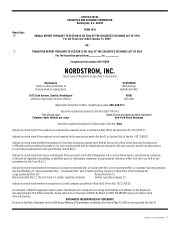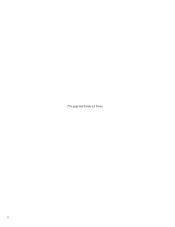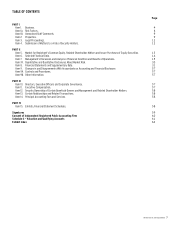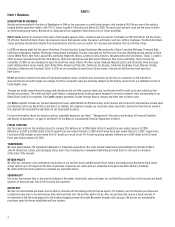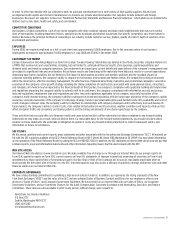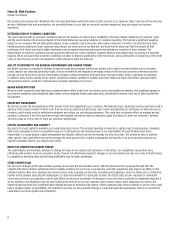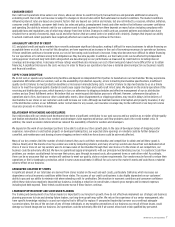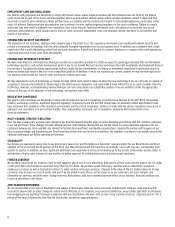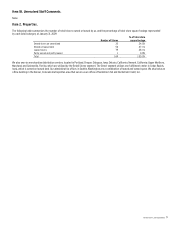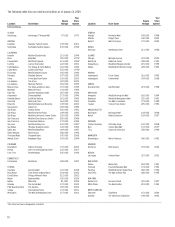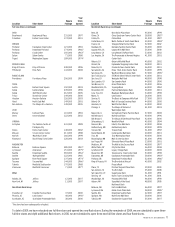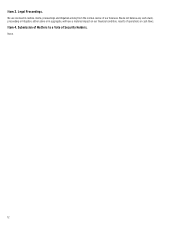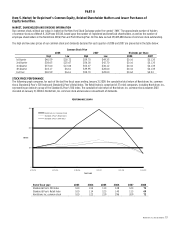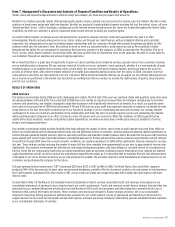Nordstrom 2008 Annual Report Download - page 6
Download and view the complete annual report
Please find page 6 of the 2008 Nordstrom annual report below. You can navigate through the pages in the report by either clicking on the pages listed below, or by using the keyword search tool below to find specific information within the annual report.6
Item 1A. Risk Factors.
(Dollars in millions)
Our business faces many risks. We believe the risks described below outline the items of most concern to us. However, these risks are not the only ones
we face. Additional risks and uncertainties, not presently known to us or that we currently consider immaterial, may also impair our business
operations.
DETERIORIATION OF ECONOMIC CONDITIONS
The recent deterioration in economic conditions has hurt our business in several ways. Instability in the stock market, tightening of consumer credit
and the recent decline in the housing market in the United States has caused a reduction in consumer spending. This has had a significant negative
impact on our revenues. We sell high-quality apparel, shoes, cosmetics and accessories, which many consumers consider to be discretionary items.
During economic downturns, fewer customers may shop in our stores and on our Web site, and those who do shop may limit the amount of their
purchases, all of which may lead to higher markdowns and increased marketing and promotional spending in response to lower demand. The
deterioration of economic conditions has also adversely affected our credit customers’ payment patterns and default rates, increasing our bad debt
expense. We do not expect that economic conditions are likely to improve significantly in the near future, and a continuation or worsening of the credit
crisis, or even the fear of such a development, could continue to harm our business.
ABILITY TO RESPOND TO THE BUSINESS ENVIRONMENT AND FASHION TRENDS
Our ability to predict or respond to changes in fashion trends and consumer preferences quickly, and to match our merchandise mix to consumer
tastes, impacts our sales and operating results. If we do not identify and respond to emerging trends in lifestyle and consumer preferences quickly
enough, we may be forced to sell our merchandise at higher average markdown levels and lower average margins, which could harm our business.
In addition, many factors outside of our control, including consumer confidence, weather and other hazards of nature that affect consumer traffic,
and general economic conditions could decrease consumer spending at our stores.
BRAND AND REPUTATION
We have a well-recognized brand that many customers believe offers a high level of customer service and quality merchandise. Any significant damage to
our brand or reputation could negatively impact sales, reduce employee morale and productivity, and diminish customer trust, any of which would harm
our business.
INVENTORY MANAGEMENT
We strive to ensure the merchandise we offer remains fresh and compelling to our customers. We make decisions regarding inventory purchases well in
advance of the season in which it will be sold. If we are not successful at predicting our sales trends and adjusting our purchases, we may have excess
inventory, which would result in additional markdowns and reduce our operating performance. This could have an adverse effect on margins and net
earnings. Conversely, if we fail to purchase enough merchandise, we may not have an adequate supply of products to meet our customers’ demand.
This may cause us to lose sales or harm our customer relationships.
CAPITAL MANAGEMENT AND LIQUIDITY
Our goal is to invest capital to maximize our overall long-term returns. This includes spending on inventory, capital projects and expenses, managing
debt levels, managing accounts receivable through our credit business and returning value to our shareholders through dividends and share
repurchases. To a large degree, capital management and liquidity reflects how well we manage our other key risks. The actions we take to address
other specific risks could affect how well we manage the more general risk of capital management and liquidity. If we do not properly allocate our
capital to maximize returns, our business may suffer.
IMPACT OF COMPETITIVE MARKET FORCES
The retail industry environment continues to change for many of our vendors and customers. In the future, our competition may partner more
effectively with vendors to serve consumers’ needs. If we do not effectively respond to changes in our environment, we may see a loss of market share
to competitors, declining sales and declining profitability due to higher markdowns.
STORE GROWTH PLAN
Our five-year strategic growth plan includes opening several new full-line and Rack stores, with 28 announced store openings through 2013. We
compete with other retailers and businesses for suitable locations for our stores. Local land use and other regulations may impact our ability to find
suitable locations. New store openings also involve certain risks, including constructing, furnishing and supplying a store in a timely and cost effective
manner and accurately assessing the demographic or retail environment for a particular location. Our future sales at new, relocated or remodeled
stores may not meet our projections, which could affect our return on investment. Performance in our new stores could also be negatively impacted if
we are unable to hire employees who are able to deliver the level of service our customers have come to expect when shopping in our stores. Our
expected opening dates have sometimes been delayed because of developer plan delays. If these developer plan delays continue or worsen, they could
have a negative impact on profitability. Our inability to execute our store growth strategy in a way that generates appropriate returns on investment
could affect our future growth and profitability.

